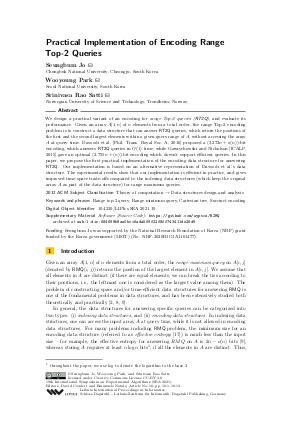Practical Implementation of Encoding Range Top-2 Queries
Authors Seungbum Jo, Wooyoung Park, Srinivasa Rao Satti
-
Part of:
Volume:
19th International Symposium on Experimental Algorithms (SEA 2021)
Part of: Series: Leibniz International Proceedings in Informatics (LIPIcs)
Part of: Conference: International Symposium on Experimental Algorithms (SEA) - License:
 Creative Commons Attribution 4.0 International license
Creative Commons Attribution 4.0 International license
- Publication Date: 2021-05-31
File

PDF
LIPIcs.SEA.2021.10.pdf
- Filesize: 1 MB
- 13 pages
Document Identifiers
Subject Classification
ACM Subject Classification
- Theory of computation → Data structures design and analysis
Keywords
- Range top-2 query
- Range minimum query
- Cartesian tree
- Succinct encoding
Metrics
- Access Statistics
-
Total Accesses (updated on a weekly basis)
0Document
0Metadata
Abstract
We design a practical variant of an encoding for range Top-2 queries (RT2Q), and evaluate its performance. Given an array A[1,n] of n elements from a total order, the range Top-2 encoding problem is to construct a data structure that can answer RT2Q queries, which return the positions of the first and the second largest elements within a given query range of A, without accessing the array A at query time. Davoodi et al. [Phil. Trans. Royal Soc. A, 2016] proposed a (3.272n + o(n))-bit encoding, which answers RT2Q queries in O(1) time, while Gawrychowski and Nicholson [ICALP, 2015] gave an optimal (2.755n + (n))-bit encoding which doesn't support efficient queries. In this paper, we propose the first practical implementation of the encoding data structure for answering RT2Q. Our implementation is based on an alternative representation of Davoodi et al.’s data structure. The experimental results show that our implementation is efficient in practice, and gives improved time-space trade-offs compared to the indexing data structures (which keep the original array A as part of the data structure) for range maximum queries.
Cite As Get BibTex
Seungbum Jo, Wooyoung Park, and Srinivasa Rao Satti. Practical Implementation of Encoding Range Top-2 Queries. In 19th International Symposium on Experimental Algorithms (SEA 2021). Leibniz International Proceedings in Informatics (LIPIcs), Volume 190, pp. 10:1-10:13, Schloss Dagstuhl – Leibniz-Zentrum für Informatik (2021)
https://doi.org/10.4230/LIPIcs.SEA.2021.10
BibTex
@InProceedings{jo_et_al:LIPIcs.SEA.2021.10,
author = {Jo, Seungbum and Park, Wooyoung and Satti, Srinivasa Rao},
title = {{Practical Implementation of Encoding Range Top-2 Queries}},
booktitle = {19th International Symposium on Experimental Algorithms (SEA 2021)},
pages = {10:1--10:13},
series = {Leibniz International Proceedings in Informatics (LIPIcs)},
ISBN = {978-3-95977-185-6},
ISSN = {1868-8969},
year = {2021},
volume = {190},
editor = {Coudert, David and Natale, Emanuele},
publisher = {Schloss Dagstuhl -- Leibniz-Zentrum f{\"u}r Informatik},
address = {Dagstuhl, Germany},
URL = {https://drops.dagstuhl.de/entities/document/10.4230/LIPIcs.SEA.2021.10},
URN = {urn:nbn:de:0030-drops-137827},
doi = {10.4230/LIPIcs.SEA.2021.10},
annote = {Keywords: Range top-2 query, Range minimum query, Cartesian tree, Succinct encoding}
}
Author Details
Funding
Seungbum Jo was supported by the National Research Foundation of Korea (NRF) grant funded by the Korea government (MSIT) (No. NRF-2020R1G1A1101477).
Supplementary Materials
-
Software (Source Code)
https://github.com/wyptcs/R2MQ
browse
 archived version
archived version
References
-
Diego Arroyuelo, Rodrigo Cánovas, Gonzalo Navarro, and Kunihiko Sadakane. Succinct trees in practice. In Proceedings of ALENEX 2010, pages 84-97, 2010.

-
Niklas Baumstark, Simon Gog, Tobias Heuer, and Julian Labeit. Practical range minimum queries revisited. In SEA 2017, pages 12:1-12:16, 2017.

-
David Benoit, Erik D. Demaine, J. Ian Munro, Rajeev Raman, Venkatesh Raman, and S. Srinivasa Rao. Representing trees of higher degree. Algorithmica, 43(4):275-292, 2005.

-
Pooya Davoodi, Gonzalo Navarro, Rajeev Raman, and S. Srinivasa Rao. Encoding range minima and range top-2 queries. Philosophical Transactions of the Royal Society A, 372(2016):20130131, 2014.

-
Pooya Davoodi, Rajeev Raman, and Srinivasa Rao Satti. On succinct representations of binary trees. Math. Comput. Sci., 11(2):177-189, 2017.

-
Luc Devroye. On random cartesian trees. Random Struct. Algorithms, 5(2):305-328, 1994.

-
A. Farzan and J. I. Munro. A uniform paradigm to succinctly encode various families of trees. Algorithmica, 68(1):16-40, January 2014.

-
Héctor Ferrada and Gonzalo Navarro. Improved range minimum queries. J. Discrete Algorithms, 43:72-80, 2017.

-
Johannes Fischer and Volker Heun. Space-efficient preprocessing schemes for range minimum queries on static arrays. SIAM J. Comput., 40(2):465-492, 2011.

-
Harold N. Gabow, Jon Louis Bentley, and Robert Endre Tarjan. Scaling and related techniques for geometry problems. In Proceedings of STOC 1984, pages 135-143, 1984.

-
Pawel Gawrychowski and Patrick K. Nicholson. Optimal encodings for range top-k, selection, and min-max. In ICALP 2015, Proceedings, Part I, pages 593-604, 2015.

- Simon Gog, Timo Beller, Alistair Moffat, and Matthias Petri. From theory to practice: Plug and play with succinct data structures. In 13th International Symposium on Experimental Algorithms, (SEA 2014), pages 326-337, 2014. URL: https://doi.org/10.1007/978-3-319-07959-2_28.
-
Guy Jacobson. Space-efficient static trees and graphs. In FOCS 1989, pages 549-554, 1989.

-
Jesper Jansson, Kunihiko Sadakane, and Wing-Kin Sung. Ultra-succinct representation of ordered trees with applications. J. Comput. Syst. Sci., 78(2):619-631, 2012.

-
J. Ian Munro, Venkatesh Raman, and S. Srinivasa Rao. Space efficient suffix trees. J. Algorithms, 39(2):205-222, 2001.

-
Gonzalo Navarro and Kunihiko Sadakane. Fully functional static and dynamic succinct trees. ACM Trans. Algorithms, 10(3):16:1-16:39, 2014.

-
Rajeev Raman. Encoding data structures. In WALCOM 2015, pages 1-7, 2015.

-
Rajeev Raman, Venkatesh Raman, and Srinivasa Rao Satti. Succinct indexable dictionaries with applications to encoding k-ary trees, prefix sums and multisets. ACM Trans. Algorithms, 3(4):43, 2007.

-
Kunihiko Sadakane. Compressed suffix trees with full functionality. Theory Comput. Syst., 41(4):589-607, 2007.

-
Jean Vuillemin. A unifying look at data structures. Commun. ACM, 23(4):229-239, 1980.

